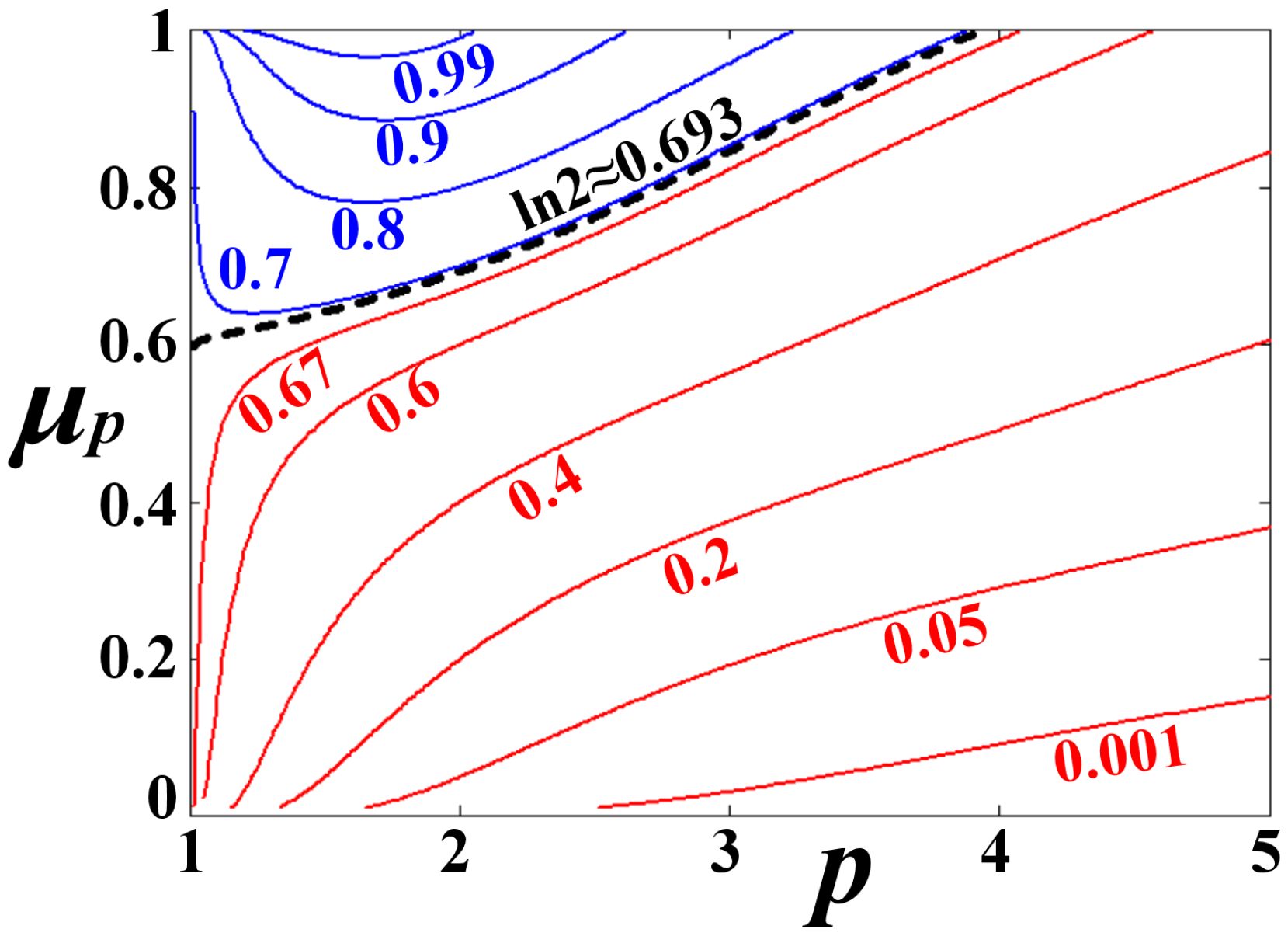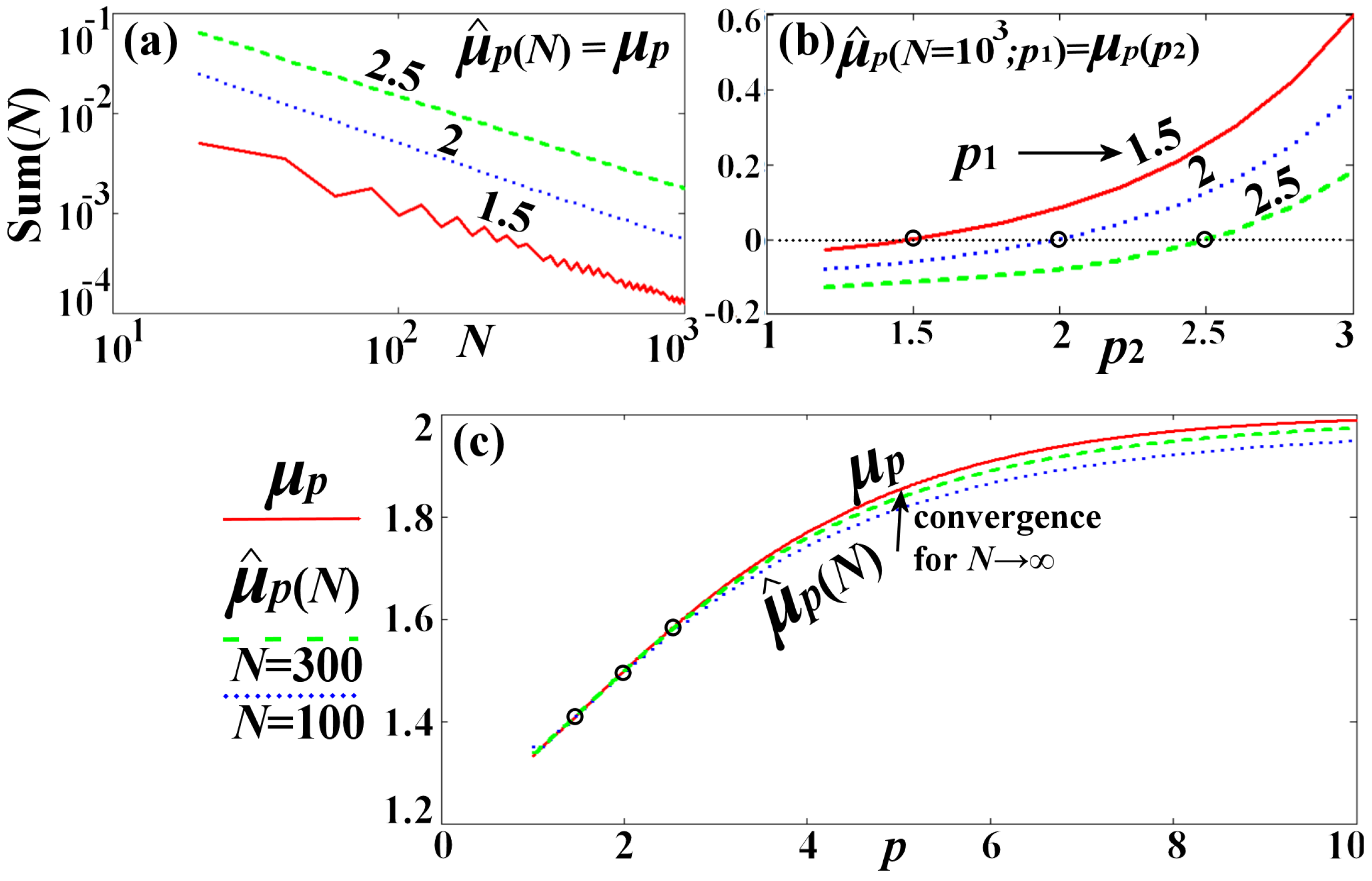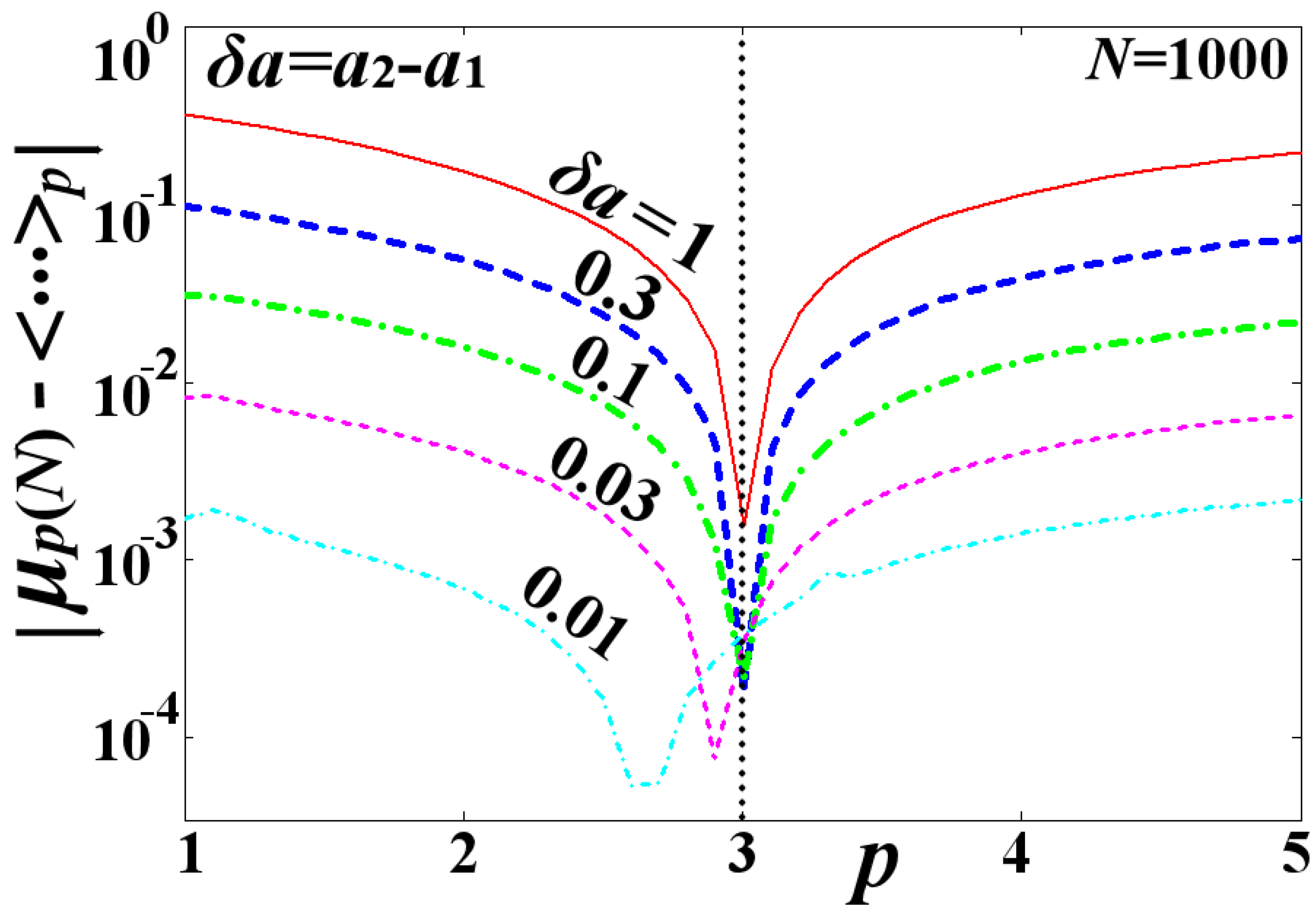1. Introduction: Definition of -Means and Their Basic Properties
In [
1,
2,
3], a generalized characterization of means was introduced, namely, the non-Euclidean means, based on metrics induced by
-norms, wherein the median is included as a special case for
(
) and the ordinary Euclidean mean for
(
) (see also: [
4,
5]). Let the set of
y-values
(
), associated with the probabilities
; then, the non-Euclidean means
, based on
-norms, are defined by
where the median
and the arithmetic mean
follow as special cases when the Taxicab
and Euclidean
-norms are respectively considered. Both the median
and arithmetic
means can be implicitly written in the form of Equation (
1) as
and
(
), respectively.
Note that the solution of Equation (
1) is a specific case of the so-called
M-estimators [
6], while it is also related to the Fréchet Means [
7]. The Euclidean norm
is also known as “Pythagorean” norm. In [
3], we preferred referring to the non-Pythagorean norms as non-Euclidean, inheriting the same characterization to Statistics. One may adopt the more explicit characterizations of “Non-Euclidean-normed” Statistics, for avoiding any confusion with the non-Euclidean metric of the (Euclidean-normed) Riemannian Geometry. As an example of an application in physics, the
expectation value of an energy spectrum
is defined by representing the non-Euclidean adaptation of internal energy
[
8].
Figure 1 illustrates an example of
-means. We use the Poisson distribution
and the dataset
, for
; hence, the
-means are implicitly given by
(note that the constant term
can be ignored). The function
is examined for various values of the
p-norm, either (a) super-Euclidean,
, or (b) sub-Euclidean
. The mean value for the Euclidean case,
, is
, which is represented by the diagonal line in both panels. We observe that for
we always have
, while for
there is a critical value
, for which
for
and
for
. The critical value
increases with
p, and as
,
. For
,
for any
, while for
,
for any values of
p.
The Law of Large Numbers is a theorem that guarantees the stability of long-term averages of random events, but is valid only for Euclidean metrics based on
-norms. The purpose of this paper is to extend the theorem of the “Law of Large Numbers” to the non-Euclidean,
-means. Namely, (i) the expectation value of the
-mean estimator (that corresponds to Equation (
1)) equals the mean of the distribution of each of the random variables; and (ii) the limit
of the
-mean estimator also equals the mean of the distributions. These are numbered as
Theorems 2 and 3, respectively. The paper is organized as follows: In
Section 2, we prove the theorem of uniqueness of the
-means (
Theorem 1). This will be used in the proofs of
Theorems 2 and 3, shown in
Section 3 and
Section 4, respectively. Finally,
Section 5 briefly summarizes the conclusions. Several examples are used to illustrate the validity of the Theorems 1–3, that is, the Poisson distribution (discrete description) and a superposition of normal distributions (continuous description).
2. Uniqueness of -Means
Here, we show the theorem of uniqueness of the -means for any . The theorem will be used in the Theorem 2 and 3 of the next sections.
Theorem 1. The curve is univalued, namely, for each , there is a unique value of the -mean .
Proof of Theorem 1. Using the implicit function theorem [
9], we can easily show the uniqueness in a sufficiently small neighbourhood of
p = 2. Indeed, there is at least one point, that is the Euclidean point
, for which the function
exists and is univalued. Then, the values of
,
, can be approximated to any accuracy, starting from the Euclidean point. The implicit function
, defined by Equation (
1), is continuous and
; then
is univalued in some domain around
. The first derivative
is finite
(e.g., for
we have
). Indeed, the inverse derivative is non-zero for any
p, i.e.,
☐
The inverse function,
, should be continuous and differentiable according to Equation (
2). If
were multi-valued, then, it should have local minima or maxima. However, the derivative
is non-zero. Therefore, we conclude that
cannot be multi-valued, and there is a unique curve
that passes through
.
As an example,
Figure 2 plots the
-means of the Poisson distribution shown in
Figure 1, but now as a function of the
p-norm, and for various values of
. For
, the function
is monotonically increasing with
p. On the contrary, for
, the function
is not monotonic, having a minimum in the region of sub-Euclidean norms,
. The separatrix between these two behaviors of
is given for
. We observe that the function
is differentiable,
is always finite or
is always non-zero, thus
is unique for any value of
p.
Finally, we note that the uniqueness of
for a given
p does not ensure monotonicity, as different values of
p may lead to the same
-mean. Such an example is the
-means of the Poisson distribution for
, shown in
Figure 2. As stated and illustrated in [
3], when the examined probability distribution is symmetric, then the whole set of
-means degenerates to one single value, while when it is asymmetric, a spectrum-like range of
-means is rather generated.
3. The Concept of -Expectation Values
Given the sampling
, the
-mean estimator
is implicitly expressed by
Then, the
expectation value of
, namely
, is implicitly given by
where
is the normalized joint probability density, so that
Definition 1. Let the sampling , , of the set of random variables . This set is called symmetrically distributed if the joint distribution density has the property , . This property is formally called Exchange-ability [10] and will be used in Lemmas 1 and 2. Next, we postulate and prove Lemmas a and 2, which are necessary for the following Theorem 2 about the expectation value of the -mean estimator.
Lemma 1. The symmetrically distributed random variables are characterized by the same expectation value, namely, , which is implicitly given bywhere , , is the marginal distribution density, that is identical for all the random variables . Proof of Lemma 1. The
-marginal probability density,
, is
so that
Given the symmetrical joint distribution, we have
Hence, the expression of the marginal distribution density is identical , i.e., for all the random variables, .
Then, we readily derive that the random variables
are characterized by the same
expectation value, namely,
, which is implicitly expressed by
Indeed, if we had
, then
and for
,
However, given the uniqueness of the
-means, Equations (
11) and (
12) lead to
=
, or
,
. ☐
Lemma 2. Let the auxiliary functionals , with , . Then, their expectation values are zero, namely, , .
Proof of Lemma 2. The
expectation value of
is implicitly given by
If
, then
while if
, then the above functional has to be non-zero, because of the uniqueness of
expectation values, namely,
Now, rewriting Equation (
15) for an index
, we have
because of the symmetrical distribution of random variables
, i.e.,
,
, (the same symmetry holds also for the estimator
, while the integration on each
spans the same integral
. Hence,
. Then, by summing both sides of Equation (
15) with
, we conclude in
or
. Thus, Equation (
14) holds, and given the uniqueness of
expectation values, we conclude in
,
. ☐
Theorem 2. Consider the sampling , , of the symmetrically distributed random variables . According to Lemma 1
, the random variables are characterized by the same expectation value (assuming that this exists), namely, , which is implicitly expressed by Equation (6). Then, the expectation value of the -mean estimator is equal to , i.e., or Proof of Theorem 2. (For useful inequalities, see [
11]) Apparently, the following integral inequalities hold:
and,
,
Furthermore, we consider the
expectation value of the functional
, namely,
, which is implicitly given by
If
, then,
while if
, then the above functional has to be non-zero, because of the uniqueness of
expectation values, namely,
or
☐
First case, : Hence, , and from the power inequality holding , we have the following:
The triangle inequality gives
. Then, applying the above power inequality for
,
, and
, we have
. Thereafter, Equation (
23) becomes
or
Second case, : Hence,
, and applying the Minkowski inequality on Equation (
23), we have
or
Combining Equations (
25) and (
27), we conclude in an inequality that holds
,
On the other hand, Equations (
18) and (
19) imply that
We construct the auxiliary random variables
, defined by
, having values
in the domain
(where
is the infimum of
, while
is the supremum of
). The
-mean estimator of the set
is given by the functional
, while the random variables
have the common
expectation value
. The respective joint probability density is given by
, so that,
. Then, Equations (
28) and (
29) become
and
respectively (where
is the identical marginal distribution density for all the random variables
).
Moreover, we define the nonnegative quantities
, determined by the integral operator
, given by
which acts on the probability densities
so that
Now consider the subset
of all the possible values of
. Equation (
30) yields
, so that the infimum
(Note that, in this case, the infimum is element of
, obtained for
). On the other hand, Equation (
31) yields
, which reads that the nonnegative quantities
can be arbitrary small, even zero, so that the infimum is now given by
.
However, the infimum is unique. The false by contradiction comes from the statement
. Hence,
, and Equation (
20) yields
, i.e.,
, or
.
4. Limit of the -Mean Estimator
The following theorem derives the limit of -mean estimator .
Theorem 3. Let the sampling , , of the independent and identically distributed random variables . The -mean estimator converges to its expectation value, , as , namely, .
Notes:
Obviously, the independent and identically distributed random variables are also symmetrically distributed. Thus, according to Theorem 2, we have .
The expectation value should be calculated given the marginal distribution density , . However, the expression of this distribution is usually unknown, and thus, we estimate by means of .
Proof of Theorem 3. We construct the set of auxiliary random variables , defined by , and having the relevant sampling values , with domain . Apparently, are also independent and identically distributed random variables, and let be the identical marginal distribution density for all the random variables . ☐
Then, the Euclidean expectation value of each of the random variables is
. Thereafter, from the “Law of Large Numbers” we have that
converges to zero, as
[
12,
13,
14]. Thus,
On the other hand, Equation (
3), for
(assuming the convergence of the sum at this limit), is written as
while, given the uniqueness of
, we conclude in
.
As an application, we examine the probability distribution
, constructed by the superposition of two different normal distributions
and
with
; namely,
. For
, the constructed probability distribution is symmetric, and as explained in
Section 3 and [
3], the whole set of
-means degenerates to one single value—in our case
,
. First, we derive the
-mean of the distribution,
, where
. Then, we compute the
-mean estimator
, where the
y-values,
, follow the probability distribution constructed above,
. The
Ny-values are generated as follows: we derive the cumulative distribution of
, that is
, and then we set the parametrization
, from where we solve for
. The estimator
is implicitly given by
; then, we demonstrate
Theorem 3 showing the equality
; in particular, we construct the sum
, and show that
, satisfying Equation (
35).
Figure 3 illustrates the convergence
. Panel (a) plots the sum
as a function of
N and for the norms
, 2, and
; we find a convergence rate of
. Panel (b) plots the summation
for large
N, which becomes zero only if the
p-norm used by the estimator
, that is
, equals the
p-norm used by the mean
, that is
. Finally, panel (c) plots the value of the estimator
, as a function of the norm
p, for two data numbers
and
, showing the convergence to
, which is co-plotted as a function of
p.
Figure 4 plots the deviation between the
-mean estimator
and the mean
, that is,
, and for a large number of data (
). The mean
is taken for the norm
, while the deviation is plotted as a function of the norm
p of the estimator. We observe that the deviation is minimized, tending to zero, when the norm is
. However, this result holds if the distribution is not symmetric. Once the parameter
decreases approaching zero, the distribution
becomes symmetric and the deviation
obtains small values (while its minimization at a certain
p loses its meaning). We observe that for
or smaller, the deviation is small enough—of the order of
(it is non-zero because of the computation errors caused by the finite
N), so that
.
5. Conclusions
The Euclidean
means are derived by minimizing the sum of the total square deviations, i.e., the Euclidean variance. In a similar way, the non-Euclidean
means were developed by minimizing the sum of the
deviations, that is proportional to the
variance [
3]. The main advantage of the new statistical approach is that the
p-norm is a free parameter, thus both the
-normed expectation values and their variance are flexible to analyze new phenomena that cannot be described under the notions of classical statistics based on Euclidean norms. The least square method based on the Euclidean norm,
, and the least absolute deviations method based on the “Taxicab” norm,
, are some cases of the general fitting methods based on the
-norms (e.g., [
15]; for more applications on the fitting methods based on Lp norms, see: [
2,
4,
16,
17]; several other applications can be in signal processing optimization and block entropy analysis, e.g., [
2]; in image processing, e.g., [
18]; in general data analysis, e.g., [
5]; in statistical mechanics, e.g., [
3,
8,
19]. The Law of Large Numbers is a theorem that guarantees the stability of long-term averages of random events, but is valid only for metrics induced by the Euclidean
norm. The importance of this paper is in extending this theorem for
-norms. Other interesting applications will be to establish a central limit theorem applied for the
-means.








